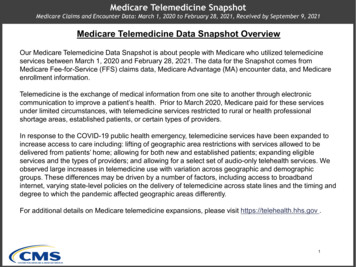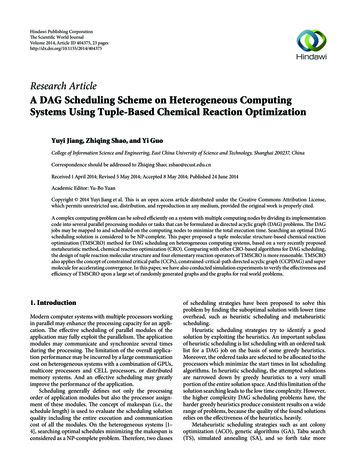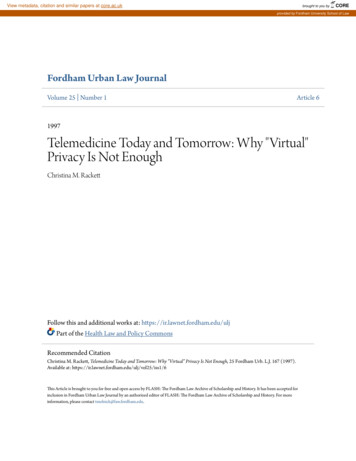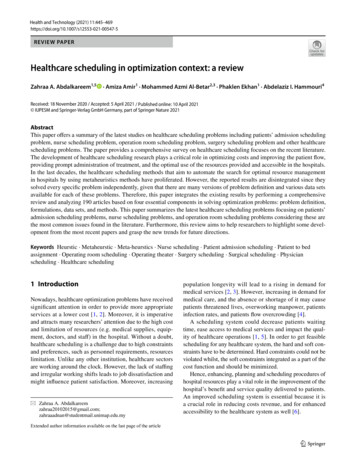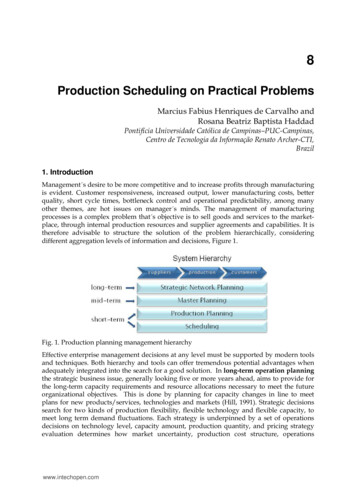
Transcription
Guidelines for Telemedicine Schedulingand Patient Care Co-ordination
Content Overview1Introduction to Scheduling and Patient Care Coordination2Model 1: Healthcare Provider Managed Scheduling and Patient Care3Model 2: Patient Site Managed Scheduling and Patient Care6OTN’s Role: We are Here to Help!9Guidelines for Telemedicine Scheduling and Patient Care Coordination
Introduction to Scheduling and Patient CareCoordinationThe Ontario Telemedicine Network (OTN) facilitates the useof videoconferencing and other technology to connecthealthcare professionals, providers and patients in wayswhich enable them to overcome barriers created by timeand distance. The result is improved and timely costeffective access to care, and a more efficient use of thehealth system’s resources.Based on a decade of experience schedulingtelemedicine appointments, Ontario Telemedicine Network(OTN) is leveraging advancements in technology to better equip our members with the real-timeinformation, convenient and collaborative tools they need to schedule patient appointments through asecure and private network that safeguards patient privacy. To reach this goal, and provide you withflexibility and control over your scheduling activity, OTN has implemented the following guidelines for directonline scheduling and coordination between healthcare providers and patient sites across Ontario throughthe use of our online scheduling tool Ncompass. These guidelines:1Safeguard Privacy andSecurity of PatientInformation2Identify the roles andresponsibilities of all telemedicineparticipants during scheduling3Ensures scheduling is keptonline where appointmentscan be easily initiated,modified and trackedAll organizations will be expected to transition integrated scheduling in to their practice by December 31,2017. Implementing this process results in the efficient delivery of telemedicine through a streamlinedscheduling process and collaboration between providers with the following benefits: Protects a patient’s privacy Offers a single point of contact for the patientProvides your office greater control to independently manage yourtelemedicine appointments and patientsSupports continuity and sustainability of your telemedicine practiceIncreases patient satisfaction and overall appointment qualityAs of August, 2014 OTN introduced a provincial standard for bookingtelemedicine appointments based on two recommended clinical schedulingmodels: Healthcare Provider Manages Scheduling and Patient Care, and Patient Sites Manages Schedulingand Patient Care.2Guidelines for Telemedicine Scheduling and Patient Care Coordination
Healthcare Provider Managed Schedulingand Patient CareModel1Roles and ResponsibilitiesIn this model, the Healthcare Provider and their support stafftriage, schedule and contact patients to be seen fortelemedicine appointments as part of their existing patientmanagement process. OTN wants to make scheduling atelemedicine appointment as easy as scheduling a face-toface appointment. Notifying a patient about an upcomingtelemedicine appointment should be treated no differentlythan notifying a patient about an upcoming procedure or inoffice follow up.Below are the roles and responsibilities of each telemedicine participant under this model:Healthcare Provider and OfficeAppointment Scheduling:Patient SitePrior to Appointment:Prior to Appointment:Initiate telemedicineappointment bookings inNcompassMaintain an up-to-date andaccurate status of systemavailability within NcompassCompletes any requiredassessments or lab work pto the appointmentProvide pertinent documents(i.e. assessment forms andprotocols)Indicate nursing support andequipment availability onlineIndicates any special requto Healthcare Provider orSend confirmations onlineCoordinate changes orcancellationsPatient Contact:Call and notify patients ofappointments, cancellationsor changesConfirm Availability Online:Promptly confirm availabilityof system, nursing andequipment support afterreceiving a requestNotify the HealthcareProvider immediately of anycancellations or interruptionswhether planned or notEnsure patients complete allpre-work and send follow-uplettersManage Protocols and DiagnosticRequirements:Manage all essential preappointment diagnosticrequirements (e.g. lab-results,EGGs, assessments etc )3PatientGuidelines for Telemedicine Scheduling and Patient Care CoordinationCall Healthcare Providerahead for cancellation
Model1How to Implement Model 1:A Step-by-Step OverviewBelow are step-by-step instructions on how to incorporate Model 1 into your workflow. These steps should beconsidered best practice for scheduling a telemedicine appointment as a healthcare provider.Step 1: Accepting a Telemedicine RequestUpon receiving a request for an appointment - the Healthcare Provider needs to determine whethera telemedicine appointment is appropriate. This might be based on the condition, specialty anddiagnostic requirements. Triaging the patient determines how quickly the patient will be seen.Step 2: Creating a Telemedicine Appointment (online)Staff creates the appointment online in Ncompass - the primary tool for communication,collaboration and coordination among all participants across Ontario. The patient information, timesand systems can be added as the appointment is in process of being scheduled.Step 3: Reserving Systems (online)Your studio and the patient’s site studio must be confirmed. This can be managed throughNcompass or alternatively through phone or email.Let’s start with your system:- The Healthcare Provider’s system could be a Personal Videoconferencing (PCVC) system ora video/desktop office system. If the Healthcare Provider is using a hospital studio/system,you must reserve the date and time with the Telemedicine Coordinator at that site inadvance of booking.Now let’s look at booking the Patient Site system:- If a preferred patient site has not been identified, your staff can use Ncompass or theTelemedicine Directory to find the closest and most clinically appropriate site. Studio space,nursing support, and medical peripherals, as required, must be requested at the time ofbooking.Step 4:Contacting PatientsYour staff will contact the patient as usual, providing details and requirements for the appointment.4Guidelines for Telemedicine Scheduling and Patient Care Coordination
Step 5: Scheduling Appointment and Notifying Participants (online)Staff can now schedule the appointmentonline, in Ncompass, and verify accuracyof all details. All participants must benotified that the appointment is confirmedby utilizing the ‘Notify Participants’ button.To make sure the appointment iscompletely scheduled in Ncompass:- Ensure both sites and systems areapproved/confirmed (includingresources and peripherals)- Ensure both sites are aware of theappointment details (includingprotocols and assessment forms)Confirm the patient for the appointment:- A patient letter can be generated from Ncompass to help inform the patient of the processfor registering and locating the telemedicine studio at the patient site.- A patient letter is also useful to remind the patient of their appointment. Please note, thepatient letter should be sent at least 5 days prior to the scheduled appointment.5Guidelines for Telemedicine Scheduling and Patient Care Coordination
Model2Patient Site Managed Schedulingand Patient CareRoles and ResponsibilitiesIn this model, the Patient Sites maintain the patientrelationship by scheduling and notifying their patients. ThePatient Site also has an established relationship with theHealthcare Provider. This relationship can stem fromparticipating in a program or from practicing in a specificcatchment area. Patients look to Telemedicine Coordinatorsand Healthcare Providers at the Patient Site in theircommunity for initial appointment information, lab work orany other appointment clarifications or rescheduling.Below are the roles and responsibilities of each telemedicine participant under this model:Healthcare Provider and OfficeTriage:Accept telemedicine requestTriage patientAppointment Scheduling:Create appointment online inNcompassCommunicate protocolrequirements with Patient SiteThis is a negotiation betweensites – often this step is doneby the Patient siteRole Definitions andCollaboration:Roles played by Patient Siteand Healthcare Provider insupporting telemedicinescheduling activities arenegotiated betweenHealthcare Providers andPatient SitesPatient SitePrior to Appointment:Maintain an up-to-date andaccurate status of systemavailability within NcompassIndicate nursing support andequipment onlineAppointment Scheduling:Initiate and confirmtelemedicine appointmentbookings in NcompassNotify Healthcare Provider ofcancellations or changesPatient Contact:Notify the patient ofappointments, cancellationsor changesEnsure patients complete allpre-work and send follow-upManage Protocols and Diagnosticrequirements:Manage all essential preappointment diagnosticrequirements (i.e. lab results,ECGs, assessments etc )6Guidelines for Telemedicine Scheduling and Patient Care CoordinationPatientPrior to Appointment:Completes any requiredassessments or lab work priorto the appointmentIndicate any special requeststo Healthcare Provider ordelegateCall ahead for cancellation
How to Implement Model 2:A Step-by-Step OverviewModel2Below are step-by-step instructions on how to incorporate Model 2 into your workflow. These steps shouldbe considered best practice for scheduling a telemedicine appointment as a patient site.Step 1: Managing a Telemedicine RequestUpon receiving a request for an appointment, the Patient Site coordinator reviews and triages thereferrals based on the Healthcare Provider’s criteria in their protocol. In some cases this informationwould be sent to the Healthcare Provider for approval before booking, which may be might base oncondition, specialty and diagnostic requirements.Step 2: Creating a Telemedicine Appointment (online)The Healthcare Provider communicates their availability (usually a dedicated block of time) to theparticipating Patient Sites. This can be easily completed by creating a ‘draft’ clinic within the onlineNcompass tool and sharing this information with the participants using the “Notify Participants”feature.The Patient Site Coordinator then creates the appointment online in Ncompass.Ncompass is the main tool for communication, collaboration and coordination among allparticipants across Ontario.Step 3a: Reserving Systems (online)Your studio and the patient’s site studio must be confirmed. This can be managed throughNcompass or alternatively through phone or email.Let’s start with your system:- The Healthcare provider’s system could be a Personal Computer Videoconferencing (PCVC)system or a video/desktop office system. If the Healthcare Provider is using a hospitalstudio/system, you must reserve the date and time with the Telemedicine Coordinator at thatsite in advance of booking.Now let’s look at booking the Patient Site system:- If a preferred patient site has not been identified, your staff can use Ncompass or theTelemedicine Directory to find the closest and most clinically appropriate site. Studio space,nursing support, and medical peripherals, as required, must be requested at the time ofbooking.7Guidelines for Telemedicine Scheduling and Patient Care Coordination
Step 3b:Adding Patients, Changing Systems(online)Upon receiving availability from the HealthcareProvider, the Patient Site can register . Patient information, times andsystems can be added and managed as theappointment is in process of being scheduled.Information for multiple patients can also beentered if many patients are being seen in agroup or after one another with the sameHealthcare Provider.Step 4:Contacting PatientsThe Patient Site will contact the patient with details and requirements for the appointment.A patient letter can be generated from Ncompass to help inform the patient of the process forregistering and locating the telemedicine studio at the patient site.A patient letter is also useful to remind the patient of their appointment. Please note, the patientletter should be sent at least 5 days prior to the scheduled appointment.Step 5: Scheduling Appointment and Notifying Participants (online)The Patient site can now schedule the appointment online, in Ncompass, and verify accuracy of alldetails. All participants must be notified that the appointment is confirmed by using the ‘NotifyParticipants’ button.To make sure the appointment is completely scheduled in Ncompass:- Ensure both sites and systems are approved/confirmed (including resources and peripherals)- Ensure both sites are aware of the appointment details (including protocols and assessmentforms)Confirm the patient for the appointment- A patient letter is also useful to remind the patient of their appointment. Please note, thepatient letter should be sent at least 5 days prior to the scheduled appointment.8Guidelines for Telemedicine Scheduling and Patient Care Coordination
OTN is Here to Help!To help you integrate these guidelines into your every-day practice, OTN has provided you with somevaluable tips:Tips for Healthcare ProvidersPlan Ahead: Telemedicine appointments arevery time sensitive. If there is a high risk of yourunning late, plan ahead and inform the PatientSite. If you are running a clinic, schedule somebuffer time in between appointments so that youcan be on time. Running late or not showing up forappointments has negative impact on all theappointment participants as well as otherHealthcare Providers with appointments scheduledafter yours.Stay Consistent: Dedicate a recurring time foryou to conduct telemedicine appointments toreduce scheduling and coordination activities. Forexample, consider reserving your time online fortelemedicine every week, to see your patients, in aclinic format. Your patients could be seen back toback or in a group, depending on your practice.This is especially useful to organize multiple followup appointments.ScheduleOne Eventfor Back-to-BackAppointments:It’s easier to schedule oneNcompass clinic for multiple patient appointmentsthat will be seen within the same block of time. Thisis faster and more efficient than scheduling eachpatient separately.Use the Copy Feature: If the appointment is tobe recurring, the support staff can use the mayhavecentralizedtelemedicine departments should adhere to thescheduling rules or principles for that organization.9Tips for Patient SitesUpdate your Ncompass Calendar: It’simportant that the Patient Site Coordinatorsensure that their Ncompass calendars are up todate and maintained in real time using the“Marked Time” functionality allowing for moreefficient communication across all sites.Print Appointment Confirmation: For ent confirmation can be printed fromNcompass. The confirmation will automaticallyinclude patient, system and appointmentinformation.Confirm Appointments with Patients: Patientsin remote communities can sometimes be hardto reach. It’s good practice to confirm a patientif they are seen at your site for a telemedicineappointment, or if you have more updatedcontact information. Remember to notify all otherparticipants that there was a change in theappointment status.Confirm Systems: To reduce the number ofcalls or call backs that need to be placed forsystem,nursingsupportandequipmentconfirmations Patient Sites can communicatewith the requestor directly from Ncompass byupdating and ‘Confirming’ your system for therequested appointment and using the “NotifyParticipants” button. If a system cannot beconfirmed (as it’s not available) the NotifyParticipants button can be used to inform theorganizer.Use Log Notes: Another way to communicatewith participants is through the Log Notes feature.Adding detailed notes while the appointment isin progress of being scheduled reduces phonecalls to your site about that appointment.Guidelines for Telemedicine Scheduling and Patient Care Coordination
OTN’s RoleTo ensure you can successfully adopt these models,OTN’s Customer Care will provide on-going guidanceand hands-on support.We will work with ourmembers to make telemedicine as easy as a face-toface appointment.Our Scheduling Coordinators are here to help you.They take accountability for the following clinicalappointment support activities:Scheduling AssistanceOTN schedules appointments that cannot be scheduled in Ncompass today (such as: Serial-MultiPoint clinics, appointments for non-members and providing audio lines).Appointment Modifications 5 Minutes Prior:OTN can make the changes on behalf of the requestor less than 5 minutes before the scheduledappointmentFinding a Specialist or a Patient Site:If you are unable to locate a host site or a specialist for the patient through your existing network orwith the assistance of the telemedicine directory, OTN can support you.New Member Orientation:OTN is responsible for onboarding new Ncompass users, and providing continued training support asneeded for existing users.Consultative Support:OTN provides subject matter expertise on an ongoing basis to improve online clinical schedulingprocesses and practiceIf you have any questions or would like OTN to assess your telemedicine program in relation to theseguidelines, please call at 1-855-654-0888.10Guidelines for Telemedicine Scheduling and Patient Care Coordination
1 Guidelines for Telemedicine Scheduling and Patient Care Coordination. . telemedicine appointment as easy as scheduling a face-to-face appointment. Notifying a patient about an upcoming . nursing support, and medical peripherals, as required, must be requested at the time of booking. Model 2 .
